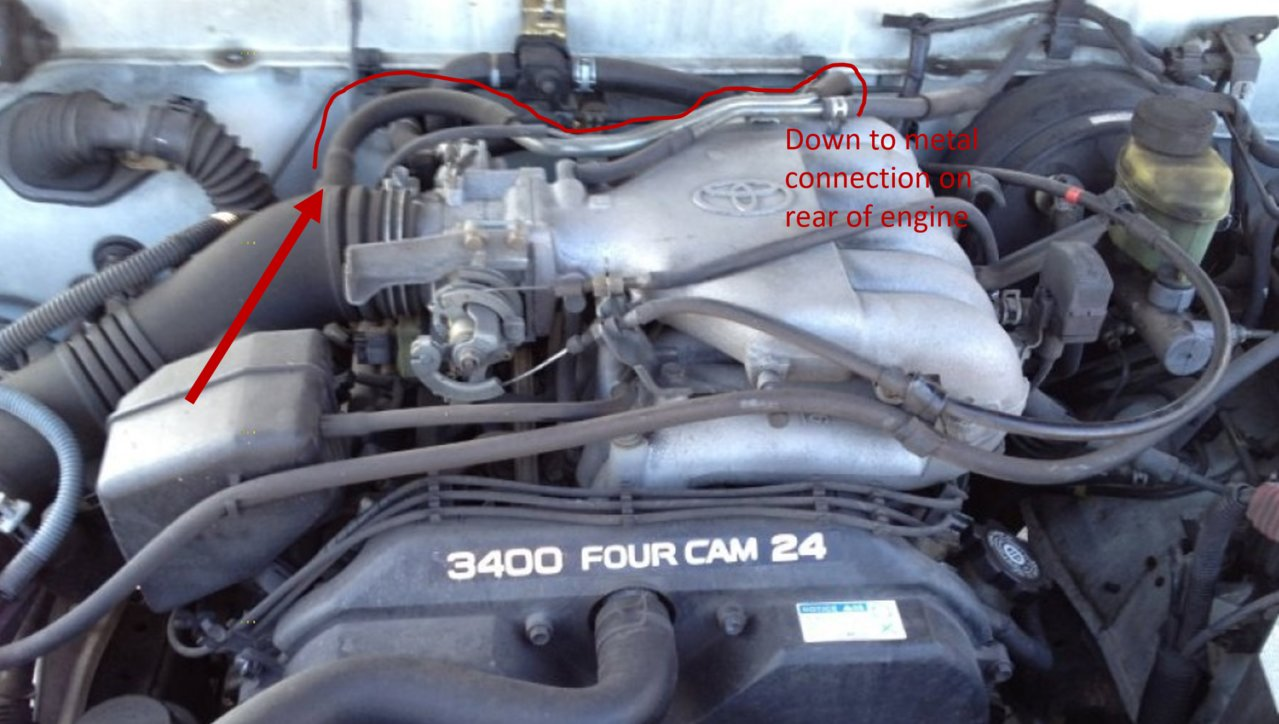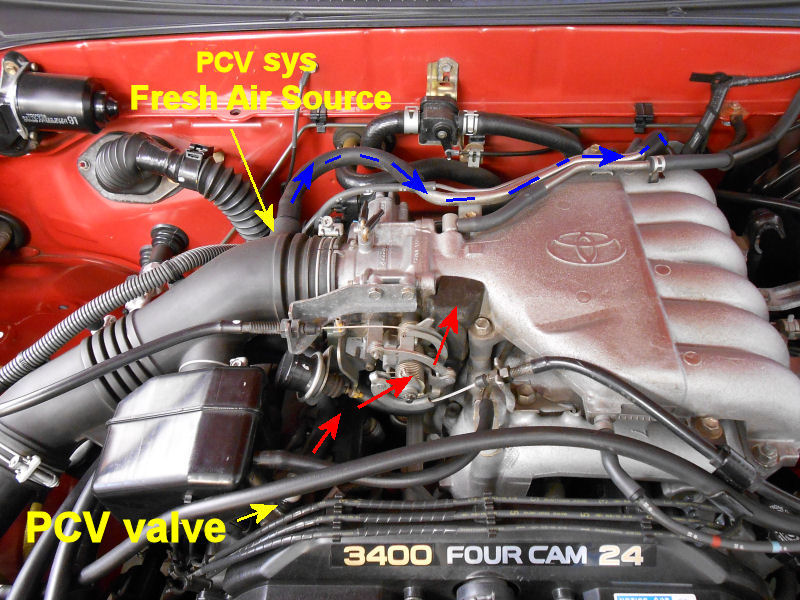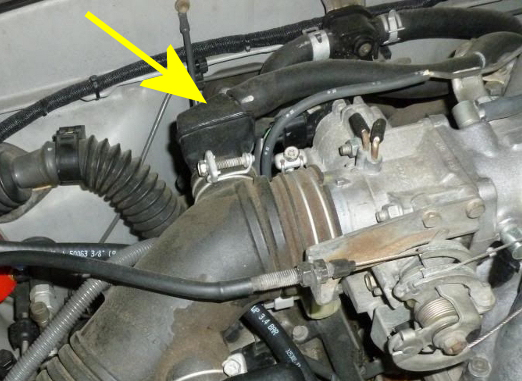You are using an out of date browser. It may not display this or other websites correctly.
You should upgrade or use an alternative browser.
You should upgrade or use an alternative browser.
Oil weeping spotted in unfamiliar spot...
- Thread starter JayQQ97
- Start date
JayQQ97
MW surVivor ... clutched. 367k on the 0D0
What have you done to your Tacoma today? 1st Gen Edition
a better test candidate would be someone with a bed that doesn't look like a 20 yr old tuna can :luvya: The hopes and dreams that hold that bed...

"So, I replaced the PCV valve today as I've had some oil seepage/wicking here and wondered if the PCV could be the culprit. The old valve seemed to be just fine (I'd replaced it already some 50K ago, for the first time in 20 years) and got me thinking.
What is this hose that comes into the intake just before the throttle body? Seems to come up and over the engine from the driver side, almost as if it would be a PCV from that side (but it looks like it just comes out of a fitting on the engine).
Also, while I'm asking dumb questions, what is the big "air box" thingy on the intake tube at the base of my arrow and what purpose does it serve?"

Last edited:
JayQQ97
MW surVivor ... clutched. 367k on the 0D0
What have you done to your Tacoma today? 1st Gen Edition
a better test candidate would be someone with a bed that doesn't look like a 20 yr old tuna can :luvya: The hopes and dreams that hold that bed...

"Hey Dan, the hose you pointed out is the driver’s side valve cover vent. Similar to the PCV, but it only vents the valve cover on that side so you don’t get nearly as much flow through it and less fuel/oil mixture in the gas. I plumbed it into a catch can just to see what the difference between the two vents would be; the PCV easily gets 5 times as much fuel/oil/condensation pushed through it from the crank case.
The air box thingy is a resonator, I believe it serves to take resonance and drone out of the intake to make it quieter, and also dampens flow through the intake, for instance when you go from WOT to fully closed and the throttle plate closes very quickly. There may be other reasons for it too."
JayQQ97
MW surVivor ... clutched. 367k on the 0D0
What have you done to your Tacoma today? 1st Gen Edition
ok tell more on the seats... its not like this Taco is a luxury ride to start with. my factory seats are in excellent shape & evidently only small...
turbodbAdventureTaco

"Thanks!
I'm getting what I consider to be quite a bit of seepage at the connection between the hose (from the valve cover vent) and the intake tube. Enough that there's some oil running down the tube, all the way to the air filter. Two questions:
- Is this indicative of anything / some problem?
- I assume that a catch can is the way to solve the symptom, if I don't need to worry about the underlying issue?"
JayQQ97
MW surVivor ... clutched. 367k on the 0D0
What have you done to your Tacoma today? 1st Gen Edition
ok tell more on the seats... its not like this Taco is a luxury ride to start with. my factory seats are in excellent shape & evidently only small...

"Yeah I was getting the same thing, and the supercharger made it worse. I don’t think it indicates a problem, I think it’s just a result of an older, high mileage engine.
A catch can is a good way to address the symptom in my opinion. There are dual inlet catch cans that you could route both the PCV and valve cover vent to, that would be the way I’d go if I were to do it over again. I guarantee the PCV is pushing a lot more gunk into your intake runners that you can’t see as easily as that vent hose connection."
JayQQ97
MW surVivor ... clutched. 367k on the 0D0
What have you done to your Tacoma today? 1st Gen Edition
ok tell more on the seats... its not like this Taco is a luxury ride to start with. my factory seats are in excellent shape & evidently only small...

"That hose" is the fresh filtered air inlet for the PCV system.
Think of the PCV valve as a vacuum regulator of sorts. It allows for engine vacuum to draw fresh air through the entire engine without allowing a full on vacuum leak issue.
"Fresh" air is drawn into the ds valve cover through that hose then travels down to the crankcase then up to the pass side valve cover, thru the PCV valve and into the manifold. All this time picking up crankcase vapors/blow by and positively ventilating them.
Folks tend to get confused about "that hose" because it's connected to the intake and think the flow must be from the valve cover to the main intake tube. It's the other way around.
In theory "that hose" should be bone dry but in some cases/situations the engine can produce more blow by volume than the normal ventilating flow of the PCV system. When this happens that hose can look wet/oily.
The box is just a chamber to help deaden sound from the pluses or essentially the rhythmic shock waves in the intake flow as the intake valves open and close. There is no engine management function and many folks ditch it for a cleaner under hood look.

JayQQ97
MW surVivor ... clutched. 367k on the 0D0
What have you done to your Tacoma today? 1st Gen Edition
In a MAF system air is metered before it goes into the engine. That hose that allows fresh air is after the MAF, so any breathing it does is with...

JayQQ97
MW surVivor ... clutched. 367k on the 0D0
What have you done to your Tacoma today? 1st Gen Edition
So what are the fender skirts that don't suck, I need a full set. I can't keep up, one brand cracks to **** within a year but I forgot which. I got...

turbodb said: ↑
"Yes, that happens when the "system" is overwhelmed by excessive blow by and/or periods of low vacuum such as low(er) RPM open throttle situations. Engine wear (rings), driving style, manifold pressure and fouled, restricted or sticking PCV valve or any combination will contribute to overwhelming the system.Very interesting, thanks! Is it surprising then, that I am seeing oil leaking out of that fresh air intake/source and down my intake tube? Does that mean I have air (and oil) flowing the wrong direction?
Note: My PCV seemed to be working correctly when I pulled it (as in, I was able to blow air through one direction but not the other).
I have a pet theory that the 3.4 PCV system is "more easily" overwhelmed than it should be as indicated by the number of folks seeing wetness in that hose. It seems Toyota was aware of this because in later years they increased the diameter of "that tube" and added a metal "can" at the intake tube connection."

